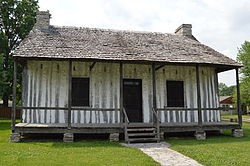
Dupo, in St. Clair County, started as a French-speaking community like many others in the State of Illinois. Symbolically, it was born under the fleur-de-lys known worldwide to be the emblem of the kings of France. Its current name is nothing more than an abridged version of its original name, “Prairie du Pont”.
The King’s Highway, also named Kaskaskia-Cahokia Trail, was the first road suitable for wagons in Illinois. When the French created permanent settlements at Kaskaskia and Cahokia, they named these two towns after the Illini Native American people, who lived there before. The King’s Highway went through the center of Prairie du Pont. A wooden bridge (“pont” in French) was built to span a stream in the meadow (“prairie” in French). This was the origin of Dupo’s name. It described the local scene with a romantic touch kindly inviting visitors to come and see for themselves.
Dupo’s French heritage
The first settlers arrived at Prairie du Pont around 1750. They came from Cahokia with the intent to be closer to their fertile farmland in the large meadow that stretched for miles to the south. The community grew up around a water mill that the monks of Saint-Sulpice congregation built on the local stream to activate the millstone. According to reliable records about fourteen francophone families lived in the village in 1760, the year Montreal surrendered to the British.

Nowadays, the only bequest of Dupo’s French period is the historic Pierre Martin House. It was built around 1790 at the intersection of First Street and Old Route 3 (King’s Highway). Over the years, maintenance and preservation works have revealed the rare structure of this gorgeous building, now listed on the U.S. National Register of Historic Places. Vertical logs were used to construct the house in the “poteaux-sur-sol” style, known in English as post on sill. The Pierre Martin House, also called the Martin Boismenue House, is one of the oldest houses in Illinois. This pearl of Colonial French Louisiana and of the old “Chemin du Roi” (King’s Highway) is a remarkable monument commemorating with pride the early American way of life in the Midwest.
A key architectural feature common to the old “Pays des Illinois” (Illinois Country) was the wide open porch, called the “galerie” (gallery), located at the front and back of the house and covered by the roof extension. This outdoor gallery had multiple practical purposes. It offered additional living space in good weather and protected the whitewashed walls from the sun and rain.